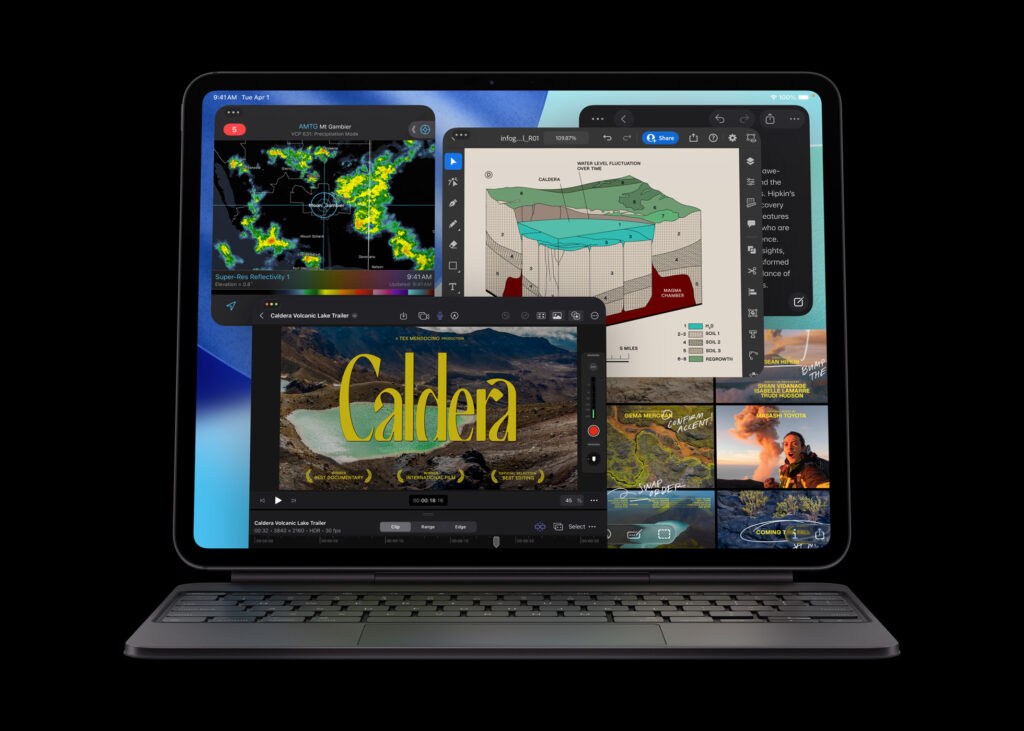
New Era: Apple Unveils iPad Pro with M5 — Where AI Meets the Tablet

By Brian k. Neal
When Apple first introduced the iPad Pro, it was meant to be the perfect hybrid — a sleek, touch-first device with enough power to challenge the laptop. For years, that vision felt close, but not quite complete. With the debut of the new iPad Pro powered by the M5 chip, Apple finally seems ready to erase the line between tablet and computer altogether. This isn’t just a spec bump; it’s a philosophical shift, signaling Apple’s most confident leap into the era of on-device AI, intelligent design, and creative freedom.
At the heart of the new iPad Pro is the M5 chip, a silicon architecture built around the idea of raw intelligence. Its 10-core GPU and 16-core Neural Engine work together to handle everything from real-time 3D rendering to generative AI image creation, with Apple claiming performance gains up to 3.5× faster than the M4 and nearly six times faster than the original M1. The device effortlessly handles workflows that once demanded high-end laptops — things like AI video masking, diffusion-based image generation, and live visual effects in apps like DaVinci Resolve. It’s not about benchmarks anymore; it’s about creative velocity.
The improvements go deeper than the chip itself. Unified memory bandwidth now stretches past 150 GB/s, cutting latency when multitasking between heavy apps. Storage speeds have doubled, with faster reads and writes that make editing 4K footage or managing layered Photoshop files feel seamless. The baseline configurations even start at 12 GB of unified memory, making this iPad Pro less of a “mobile device” and more of a portable production studio.

Connectivity is also taking a future-forward turn. Apple’s new N1 wireless chip introduces Wi-Fi 7 and Bluetooth 6 support, while the cellular models feature the new C1X modem capable of delivering 50% faster data throughput. For the first time, the iPad Pro even supports Thread, allowing it to act as a smart home controller within Apple’s Home ecosystem. In other words, this device isn’t just for the desk — it’s becoming a central hub for your digital life.
Aesthetically, the iPad Pro remains a minimalist marvel. The design is impossibly thin — just over 5 mm — yet rigid and refined. Its Ultra Retina XDR OLED display delivers vivid contrast and lifelike color depth, retaining the fluidity of 120 Hz while adding adaptive sync for smoother visuals when connected to external monitors. The space black and silver finishes give it a professional yet futuristic appeal, the kind of device you’d expect to see in a film about the near future. Fast charging now reaches 50% in about half an hour with Apple’s new 40-watt adapter, keeping up with the pace of modern creative workflows.
What’s most impressive, though, is not just what the M5 chip enables, but what it represents. Apple is no longer positioning the iPad Pro as an accessory to the Mac, but as an independent creative machine powered by on-device intelligence. Generative AI, local rendering, and neural processing are no longer confined to data centers or pro-level computers — they’re literally happening under your fingertips. For designers, filmmakers, and digital artists, that means faster turnarounds, fewer compromises, and more experimentation.

Still, it’s not without caveats. Pushing so much power through a chassis this thin inevitably raises questions about thermals and sustained performance under heavy load. While Apple has made strides in efficiency, running full-speed AI and rendering workloads will likely still tax the battery faster than casual use. And while the M5 chip opens new possibilities, the software ecosystem needs to catch up; apps must be rewritten to truly take advantage of its multi-core neural architecture.
But even with those challenges, the M5 iPad Pro feels like a statement. It’s Apple declaring that the tablet is not merely a convenience device — it’s the next frontier of mobile computing. With this release, the iPad is less about replacing your laptop and more about expanding what creative computing can be. It sits at the intersection of art, intelligence, and power — a place where the tools finally feel as intuitive as the ideas themselves.
The M5 iPad Pro isn’t just faster. It’s bolder, smarter, and unmistakably aimed at a future where creativity isn’t tethered to the desk. It’s Apple reminding the world that the most revolutionary ideas often arrive not with fanfare, but with quiet confidence — in the shape of something impossibly thin, and infinitely capable.







